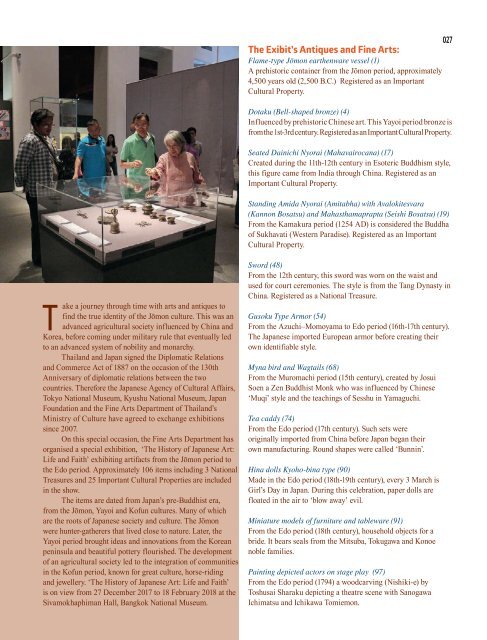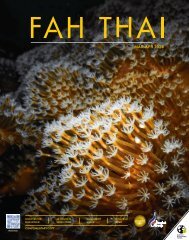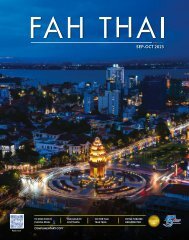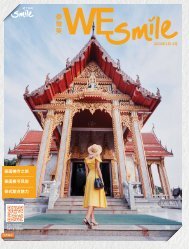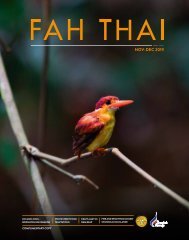WE Smile Magazine February 2018 - Thai Smile Airways
The In-Flight Magazine of Thai Smile Airways
The In-Flight Magazine of Thai Smile Airways
You also want an ePaper? Increase the reach of your titles
YUMPU automatically turns print PDFs into web optimized ePapers that Google loves.
027<br />
The Exibit’s Antiques and Fine Arts:<br />
Flame-type Jōmon earthenware vessel (1)<br />
A prehistoric container from the Jōmon period, approximately<br />
4,500 years old (2,500 B.C.) Registered as an Important<br />
Cultural Property.<br />
Dotaku (Bell-shaped bronze) (4)<br />
Influenced by prehistoric Chinese art. This Yayoi period bronze is<br />
from the 1st-3rd century. Registered as an Important Cultural Property.<br />
Seated Dainichi Nyorai (Mahavairocana) (17)<br />
Created during the 11th-12th century in Esoteric Buddhism style,<br />
this figure came from India through China. Registered as an<br />
Important Cultural Property.<br />
Standing Amida Nyorai (Amitabha) with Avalokitesvara<br />
(Kannon Bosatsu) and Mahasthamaprapta (Seishi Bosatsu) (19)<br />
From the Kamakura period (1254 AD) is considered the Buddha<br />
of Sukhavati (Western Paradise). Registered as an Important<br />
Cultural Property.<br />
Take a journey through time with arts and antiques to<br />
find the true identity of the Jōmon culture. This was an<br />
advanced agricultural society influenced by China and<br />
Korea, before coming under military rule that eventually led<br />
to an advanced system of nobility and monarchy.<br />
<strong>Thai</strong>land and Japan signed the Diplomatic Relations<br />
and Commerce Act of 1887 on the occasion of the 130th<br />
Anniversary of diplomatic relations between the two<br />
countries. Therefore the Japanese Agency of Cultural Affairs,<br />
Tokyo National Museum, Kyushu National Museum, Japan<br />
Foundation and the Fine Arts Department of <strong>Thai</strong>land’s<br />
Ministry of Culture have agreed to exchange exhibitions<br />
since 2007.<br />
On this special occasion, the Fine Arts Department has<br />
organised a special exhibition, ‘The History of Japanese Art:<br />
Life and Faith’ exhibiting artifacts from the Jōmon period to<br />
the Edo period. Approximately 106 items including 3 National<br />
Treasures and 25 Important Cultural Properties are included<br />
in the show.<br />
The items are dated from Japan’s pre-Buddhist era,<br />
from the Jōmon, Yayoi and Kofun cultures. Many of which<br />
are the roots of Japanese society and culture. The Jōmon<br />
were hunter-gatherers that lived close to nature. Later, the<br />
Yayoi period brought ideas and innovations from the Korean<br />
peninsula and beautiful pottery flourished. The development<br />
of an agricultural society led to the integration of communities<br />
in the Kofun period, known for great culture, horse-riding<br />
and jewellery. ‘The History of Japanese Art: Life and Faith’<br />
is on view from 27 December 2017 to 18 <strong>February</strong> <strong>2018</strong> at the<br />
Sivamokhaphiman Hall, Bangkok National Museum.<br />
Sword (48)<br />
From the 12th century, this sword was worn on the waist and<br />
used for court ceremonies. The style is from the Tang Dynasty in<br />
China. Registered as a National Treasure.<br />
Gusoku Type Armor (54)<br />
From the Azuchi–Momoyama to Edo period (16th-17th century).<br />
The Japanese imported European armor before creating their<br />
own identifiable style.<br />
Myna bird and Wagtails (68)<br />
From the Muromachi period (15th century), created by Josui<br />
Soen a Zen Buddhist Monk who was influenced by Chinese<br />
‘Muqi’ style and the teachings of Sesshu in Yamaguchi.<br />
Tea caddy (74)<br />
From the Edo period (17th century). Such sets were<br />
originally imported from China before Japan began their<br />
own manufacturing. Round shapes were called ‘Bunnin’.<br />
Hina dolls Kyoho-bina type (90)<br />
Made in the Edo period (18th-19th century), every 3 March is<br />
Girl’s Day in Japan. During this celebration, paper dolls are<br />
floated in the air to ‘blow away’ evil.<br />
Miniature models of furniture and tableware (91)<br />
From the Edo period (18th century), household objects for a<br />
bride. It bears seals from the Mitsuba, Tokugawa and Konoe<br />
noble families.<br />
Painting depicted actors on stage play (97)<br />
From the Edo period (1794) a woodcarving (Nishiki-e) by<br />
Toshusai Sharaku depicting a theatre scene with Sanogawa<br />
Ichimatsu and Ichikawa Tomiemon.


